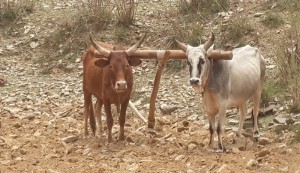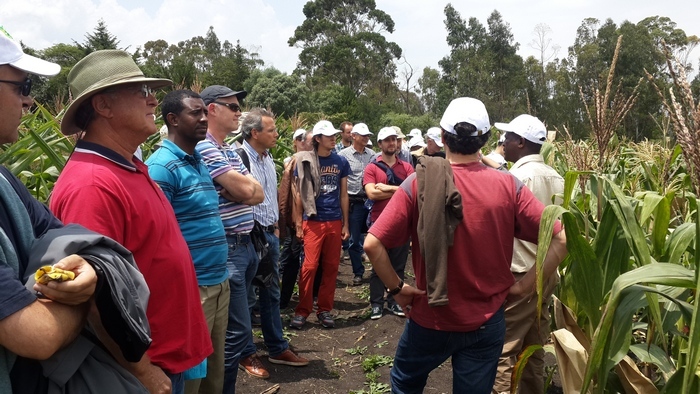Because GYGA is a crucial pointer to where the greatest gains in food production can be made, and the pains to sidestep, all in a bid to close the yawning gap on hunger by going beyond gigabytes of data to concrete actionAfrica’s food production is not limited by lack of potential. Rather, it’s a question of priorities and targeting
For this reason, let us turn to the Atlas of African agriculture research and development, which will be a crucial roadmap in navigating the Global Yield Gap Atlas (GYGA) Project’s work in Africa over the past four years (May 2012 to March 2015). Published by the International Food Policy Research Institute (IFPRI), the Atlas of African agriculture research and development jumps straight to the point in the foreword: “Africa is a paradox. This vast continent is home to almost half of the world’s uncultivated land fit for growing food crops – an estimated 202 million hectares but much of it is off-limits to farmers because it is difficult to farm or is used for other purposes.”

Life on the edge: farming fragile and frugal marginal lands along steep slopes in north Ethiopia. (Photo: K. Tesfaye, July 2015).
The heat is on, so are ways to beat the heat: Go, GYGA, Go!
“The pressure on land is enormous, resulting in agriculture creeping up steep hillsides where it does not belong, with the soil washing away,” observed Kenneth G. Cassman, GYGA Project Leader, from the University of Nebraska, USA. GYGA aims to provide information from farm level to the landscape, watershed, continent and the globe, to assure informed decisions on optimizing food production. GYGA operates on the principle that ensuring food security while protecting carbon-rich and biodiverse rainforests, wetlands, and grasslands depends on achieving the highest possible yields from existing farmland.
“Our aspiration is to have complete global coverage of all global farmland, “added Cassman. But GYGA’s quest is not just about gigabytes of data: “To feed billions in the future, we need to have not only the knowledge, but also the know-how.”
According to Samuel Adjei-Nsiah of the International Institute of Tropical Agriculture and GYGA country agronomist for Ghana, there are two options to increase food production: (1) expanding arable land; or, (2) closing the yield gap in existing farmland by expanding irrigation, intensifying cropping systems and adopting improved crop management technologies “But option one may result in significant losses of important ecosystem services such as biodiversity, while option two depends on the socioeconomic conditions of farmers, and local food preferences, cultural traditions, and markets.”
Focus on Africa
In Africa, GYGA has convened thrice before in Kenya, Benin and Ethiopia in 2012, 2013 and 2014, respectively. This year, the meeting returned to Addis Ababa, Ethiopia in what will be the close of the four-year project. “For this closing meeting, the goals are taking agronomic practices to scale, substantive collaborations in the face of climate change, and helping to prioritize research,” said Cassman.

Visit to Ambo Research Center on 22nd September by participants of the 2015 GYGA meeting in Ethiopia, 22nd to 24th September 2015. (Photo provided by K. Tesfaye, CIMMYT)
Funded by the Bill & Melinda Gates Foundation and the Water for Food Institute, GYGA covers 23 countries, of which 10 are in Africa – Burkina Faso, Mali, Ghana, Niger, Nigeria, Ethiopia, Kenya, Uganda, Tanzania and Zambia. All of GYGA’s rich information and data are fully in the public domain. “GYGA has built a great and informative website in a very short space of time. This is remarkable,” said Christian Witt, Senior Program Officer at the Bill & Melinda Gates Foundation.
What next? Sealing the gap by going from gigabytes of data to informed action
While information is very important, it is but a stepping stone in the quest to close the yawning gap on hunger .“If we stop at identifying gaps, this alone will not help us solve the problems,” observed Kindie Tesfaye, Crop and Geospatial Modeler at CIMMYT. “We need to act on this information where the opportunities for growth are. Therefore, the next step is mapping what is hampering production. For example, is it the price of seed, inputs, markets, or other factors?”
For this reason, the conclusion of GYGA’s work after four productive years also marks new beginnings for a continuation, albeit on a smaller scale in the foreseeable future. “Parts of the work will continue in Ethiopia and Ghana, focusing on maize,” said Martin Ittersum from Wageningen University and Research Centre. “This work will be funded by the UK’s Department for International Development, and begins in 2015.”
Why zero in on maize for this further work? Because in Ethiopia, GYGA cereal studies show that maize leads and teff trails in productivity (i.e., yield per unit area, see graph below), even if in area coverage and popularity it is the reverse, with teff as Ethiopia’s most popular cereal.
“In Ghana, rainfed maize has the highest yield potential at 9.5 tonnes per hectare, compared to 7.5 for sorghum, 6.6 for rice and 4.6 for sorghum,” said l Adjei-Nsiah. “With irrigation, maize still leads at 14.9 tonnes compared to rice at 8.3 tonnes.”
Elsewhere, it is a largely similar sweet story for maize. In Uganda, more than 90 percent of the maize is grown by smallholders, underscoring the significant socioeconomic impact of the benefits of research to improve maize productivity. Moving from east to west, in Mali, maize ranks fourth in productivity, after millet, sorghum and rice, in that order, while southwards in Zambia, more than 65 percent of the nation’s cropland is devoted to maize, making it the principal crop in a country where 85 percent of the population depend on agriculture. “On average, maize yields about 1.5 tonnes per hectare, compared to 0.55 for sorghum and 0.65 for millet,” said Regis Chikowo, GYGA’s country agronomist for Zambia, who however added that maize yields have been stagnant for the last two decades. Therefore, much remains to be done for this leading crop to realize its full potential in Ghana, and thereby seal the yield gap.
On-the-ground realities: global scope, but down-to-earth
GYGA is led by the University of Nebraska, Lincoln (USA) and Wageningen University and Research Centre (The Netherlands), with collaborators from the International Crops Research Institute for the Semi-Arid Tropics, the Africa Rice Center, CIMMYT, the Commonwealth Scientific and Industrial Research Organisation (Australia), and agronomists in the GYGA Project countries. All these partners participated in the GYGA closing meeting.
Also present were the Africa Soil Information Service, the CGIAR Research Program on Climate Change, Agriculture and Food Security, Harvest Choice, IFPRI, the International Rice Research Institute, and the International Soil Reference Information Centre. A fitting representation of – and emphasis on – soil, given it is the root of life, and 2015 the International Year of Soils designated by the United Nations.
Links:
- Global Yield Gap Atlas website
- Atlas of African agriculture research & development (IFPRI)
- Related CIMMYT blogpost (social science view): Yield gap analysis key to meeting future crop demand
- Global Soil Week and International Year of Soils (2015) at CIMMYT with our IMAS Project
- World Soil Day 2015 at CIMMYT
- More on CIMMYT’s Socioeconomic Program

